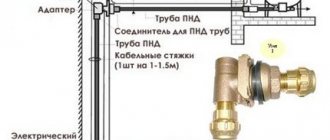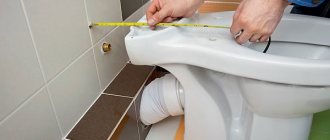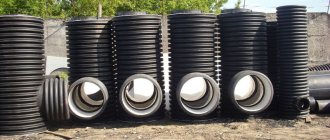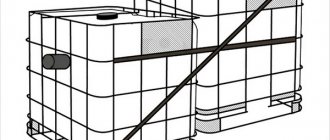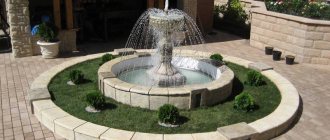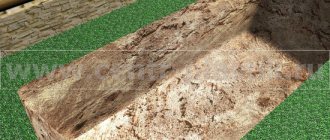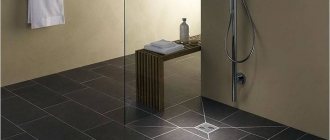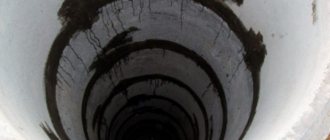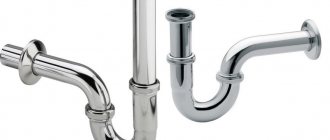Considering that in the spring-autumn period there is a fairly large amount of precipitation, it is simply impossible to do without a properly organized drainage system. Large amounts of water, especially in areas prone to flooding, will not only cause inconvenience, but will also negatively affect the road surface. The arrangement of drainage is an important detail when arranging sites, industrial areas and public areas. It will help get rid of rain and melt water, preventing it from stagnating in the area. An essential element of storm drainage is storm water inlets, which receive water flows and direct them into gutters.
Design
Storm water inlets are a complex rectangular or oval shaped structure, which consists of several elements:
- The grille ¬– closes the systems from above and also performs a decorative function. Another purpose is to prevent possible injury to people and vehicle breakdowns. The grille prevents large debris and leaves from entering the system and clogging it.
- The storm inlet itself, which receives water flows and directs them into the system.
- Sand filter - this element is not provided in all systems. Located below the rainwater inlet tray, where debris particles settle to the bottom.
The filter must be cleaned periodically, otherwise an unpleasant odor will appear as a result of the evaporation of water from the tray.
Device
The rainwater inlet has a hollow structure. It is open at the top, with a grate installed (for collecting water, repairing and cleaning). Pipelines extend from the side surfaces (to supply rainwater to the storm sewer system). Structurally, water intakes of the same type differ from each other in mass and depth.
The rainwater inlet consists of the following elements:
- housings;
- external grille;
- trash collection baskets;
- siphon partitions to prevent the spread of unpleasant odors.
Components of a rainwater inlet
Sizes of storm water inlets
Depending on the intensity of precipitation, the terrain, as well as the intended installation location, storm inlets of different sizes are selected in accordance with GOST 26008-83 and GOST 3634-99, which affect the throughput.
| Name | Gutter dimensions (mm) | Opening dimensions (mm) | Design load (kN/ton) | Installation locations | |
| Rectangular and square | DM2-S250-2-37-78 (main) | 925×480×95 | 370×780 | 250/25 | Highways, airports, industrial zones. |
| DB 800×400 (large) | 915×570×120 | 800×400 | 250/25 | Roads, squares, service stations, gas stations. | |
| DB 1-V125-2-31×49 (large) | 634×414×95 | 310×490 | 125/12,5 | Courtyards, roads, sidewalks. | |
| DB 2-V125-2-37×77 (large) | 943×473×100 | 370×770 | 125/12,5 | Courtyards, roads, sidewalks. | |
| DM 570×300 (small) | 690×470×120 | 570×300 | 50/5 | Sidewalks, pedestrian areas. | |
| D-A15-1-32×32 (small) | 456×460×60 | 326×322 | 15/1,5 | Sidewalks, individual areas. | |
| Storm drain inlet | 910×570×120 | 800×400 | 150/15 | Pedestrian areas. | |
| Round | DK round | · 870×120 · 600 | 250/25 | highways, service stations, gas stations. | |
| DC round with hinge | · 870×120 · 600 | 250/25 | highways, service stations, gas stations. | ||
| DK round | · 870×120 · 600 | 150/15 | sidewalks, courtyards. | ||
| DC round with hinge | · 870×120 · 600 | 150/15 | Pedestrian areas, courtyard areas | ||
Features of installation of surface drainage systems
Often, on an individual plot near a private house, it is necessary to collect water from paving slabs, if the slope does not allow it to be drained outside the plot, and direct it to a drainage well or outside the plot. For these purposes, surface systems are used, consisting of rainwater inlets and trays made by hand from concrete, or factory products made of plastic, concrete or polymer concrete.
It is easier and faster to assemble surface drainage from semicircular trays made of concrete or plastic; work is carried out in the following order:
- They draw up a drainage diagram linked to the site plan, indicating the slopes and direction of water movement along the trays.
- Prepare the necessary tools, the main ones of which are a building level, an angle grinder, a rubber hammer, a spatula, and a bayonet shovel.
- A drainage hole is made in the concrete polymer sand catcher and a place is prepared for installing trays, observing the required slopes. To do this, mark a line with a cord along which you dig a ditch of the required depth so that there is a free space of about 10 cm on the bottom and sides of the tray.
- The trays are laid out along dug channels, starting from the highest point of the drain and connecting to each other; if necessary, use a grinder for adjustment.
- Place a concrete pad at the bottom of the pit and lower the trays onto it, checking the slope with a level and the straightness of the direction with a previously stretched cord. The position is adjusted using a rubber hammer.
- The joints in concrete-polymer trays are sealed using the sealant included in the kit; in the last section, a plug is glued to the end.
- After the concrete has hardened, the system is covered with gratings, then the channels are lined with paving slabs; during installation, the depth of the grating should be maintained at 3 - 5 mm. below the surface level of the paving lining.
Rice. 14 Isoline map of precipitation intensity depending on the area
Kinds
Depending on the installation location and the degree of expected load, storm water inlets are selected from different materials:
Plastic
– the most popular models, which are characterized by an optimal ratio of weight and strength. They withstand high and low temperatures well and are affordable.
Concrete
– have good resistance to mechanical loads and temperature changes, increased throughput. Lightweight options are mainly mounted under the outlet of the drainpipe and are equipped with a plastic outlet. The design features of such models allow the receivers to be installed on top of each other. Heavy concrete trays can withstand loads of up to 3 tons, so the structures can be installed in areas with large traffic flows. In private construction, such options are not often used, since they are quite heavy and difficult to install due to their bulky dimensions.
Cast iron
- the most durable option, capable of withstanding more than one ton of load. Such models are most often installed on highways with high traffic flow, gas stations, and parking lots. The only drawback of such structures is their heavy weight, which complicates their installation.
SCh20 cast iron with a high level of resistance to various aggressive substances is used for production. Cast iron structures are produced in several modifications:
- DM - are light in weight and can withstand loads of up to 12.5 tons;
- DB – tanks weighing from 115 kg, can withstand loads of up to 25 tons;
- DK - round models with a design load of up to 15 tons.
There are several classes of storm water inlets with different permissible loads from 1.5 tons (class A) to 90 tons (class F).
Point rainwater inlet and winter...
To distribute horizontal forces, transverse and longitudinal compensation temperature joints must be installed at the joints of rainwater wells. You can prevent excess water from entering the stormwater system by installing a check ball valve at the junction of the stormwater inlets with the drainage pipe.
When choosing rainwater wells, preference should be given to devices with a ready-made hole for connection to the sewer pipe. If there is no suitable design, use the instructions on how to cut a hole in a storm drain:. A hole of the appropriate diameter is cut according to special markings marked on each wall of the well.
The groove of the technological seam between the rainwater inlet and the sewer pipe is sealed with polyurethane sealant.
Features of choice
When designing and choosing the type of storm drain, it is necessary to focus on the intended storm drainage system and take into account the following parameters:
- maximum precipitation level;
- features of the terrain where the installation will be performed;
- size of territory;
- maximum permissible loads on the coating;
- precipitation intensity according to SNiP.
When choosing storm water inlets for areas with harsh climates and difficult geological conditions, it is necessary to choose models made of concrete and cast iron.
One of the main parameters when choosing a model is the load class:
- A-15 – minimum load, such options are installed near private houses and on pedestrian paths.
- B-12.5 - selected when organizing a drainage system near roads, sidewalks, parking lots and gas stations.
- D-400 – designed for industrial areas and service stations.
- E-600 – used on highways and truck stops.
- F-900 – installed at airports and large industrial sites.
How to choose
Regardless of the type of drainage tank, it is necessary to select it correctly. First of all, the following factors should be taken into account:
- Estimated amount of precipitation in your area and its intensity.
- The area of the rainwater collection system.
- Features of the landscape of the local area.
If we are talking about installation near the house, then it is enough to choose a lightweight plastic drain. If there is heavy rainfall in your area, then it is better to give preference to products made of cast iron, as it copes with heavy loads more effectively. It may be worth purchasing a device for several sections or a single section will be enough. Plus, it’s good when the design has a removable basket, a siphon and a primary filter for cleaning.
Installation technology
Installation is carried out under the outlet of the drainpipe or where the largest number of puddles form. When performing installation, you need to pay special attention to the installation depth. It is also recommended to position the rain gutters so that the water flows directly into the center. If it is not possible to place the drain at the lowest point, you can first make special recesses so that water flows through them into the receiver.
Installation is carried out using the following technology:
- A pit is dug to a depth equal to the dimensions of the receiver, to which another 30-40 cm is added. The width of the pit is chosen to be larger than the dimensions of the structure by about 3 cm on each side.
- A sand cushion is placed at the bottom, which is filled with sand and compacted.
- After leveling the entire structure in height, the rainwater inlet is connected to the system of pipes and trays.
- The pit is filled with concrete, after which the receiver is installed. It is necessary to clearly fix the structure so that it does not move during operation.
- The walls of the plastic forms are additionally reinforced with a metal grid so that they do not deform after pouring the concrete.
- The rainwater inlet basket is being installed.
The efficiency and service life of the structure depends on how correctly the rainwater inlet is installed. Typically, its installation is carried out before the coating is poured on the territory.
An important factor during installation is the strength of the base. When temperature changes, the soil can expand and contract, which will affect the reliability of the structure. If you do not have sufficient knowledge to install a storm drain, it is better to entrust it to professionals. The price will depend on the type of receiver, installation depth and other factors.
Maintenance, operation and care
In order for the water drainage system, drainage and similar communications to work properly, it is necessary to take seriously the rules for operating the rainwater inlet. The whole point of care comes down to emptying the trash bin in a timely manner. 2-3 times a month is enough. If there was little rain during this period, then cleaning is not necessary.
Important! If there is heavy precipitation in your area, then care must be taken to clean not only the receiver itself, but also the pipes leading from it.
State standards
Technical features of storm water inlets are regulated by the requirements of state standards:
- GOST 26008-83 – Cast iron rainwater inlets for wells.
- GOST 3634-99 – Well hatches and storm water inlets for sewage wells.
- GOST 1855-55 – Cast iron castings. Permissible deviations in weight and dimensions for mechanical processing.
When designing a local area, an important point is the organization of storm drainage. In order to properly remove precipitation from the roof, they are positioned in such a way that the outlet part of the pipe is located strictly in the center. Only in this way will the system work efficiently, and all the water from the roofing will flow directly into the sewer system.
Why is it necessary to place rainwater inlets for storm drainage?
A modern, efficient storm drainage system contains several components that must cope with the drainage of rain and melt water. These include:
- Linear external water collectors, which are installed at a slope along the blind area and paths;
- Point storm inlets that collect water coming from downspouts, linear catch basins, and low-lying areas in the landscape where a lot of water quickly accumulates.
Usually, without installing an entire system of storm water inlets, it is impossible to effectively organize the collection and drainage of rain and melt water from a site, especially in areas with complex landscapes, where it is simply impossible to solve the problem with the help of linear gutters due to the lack of a natural slope of the area towards the boundaries of the site from its center.
